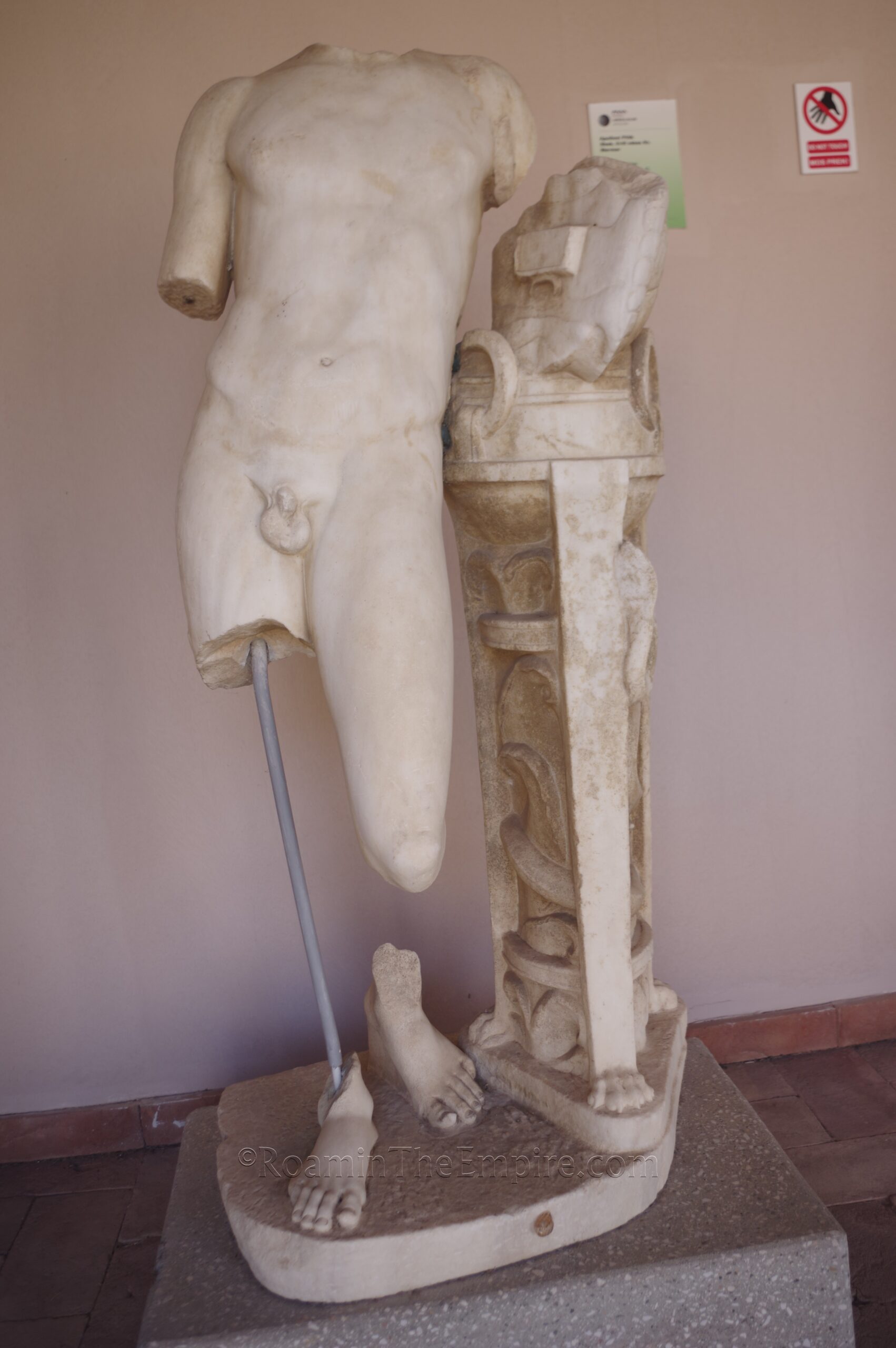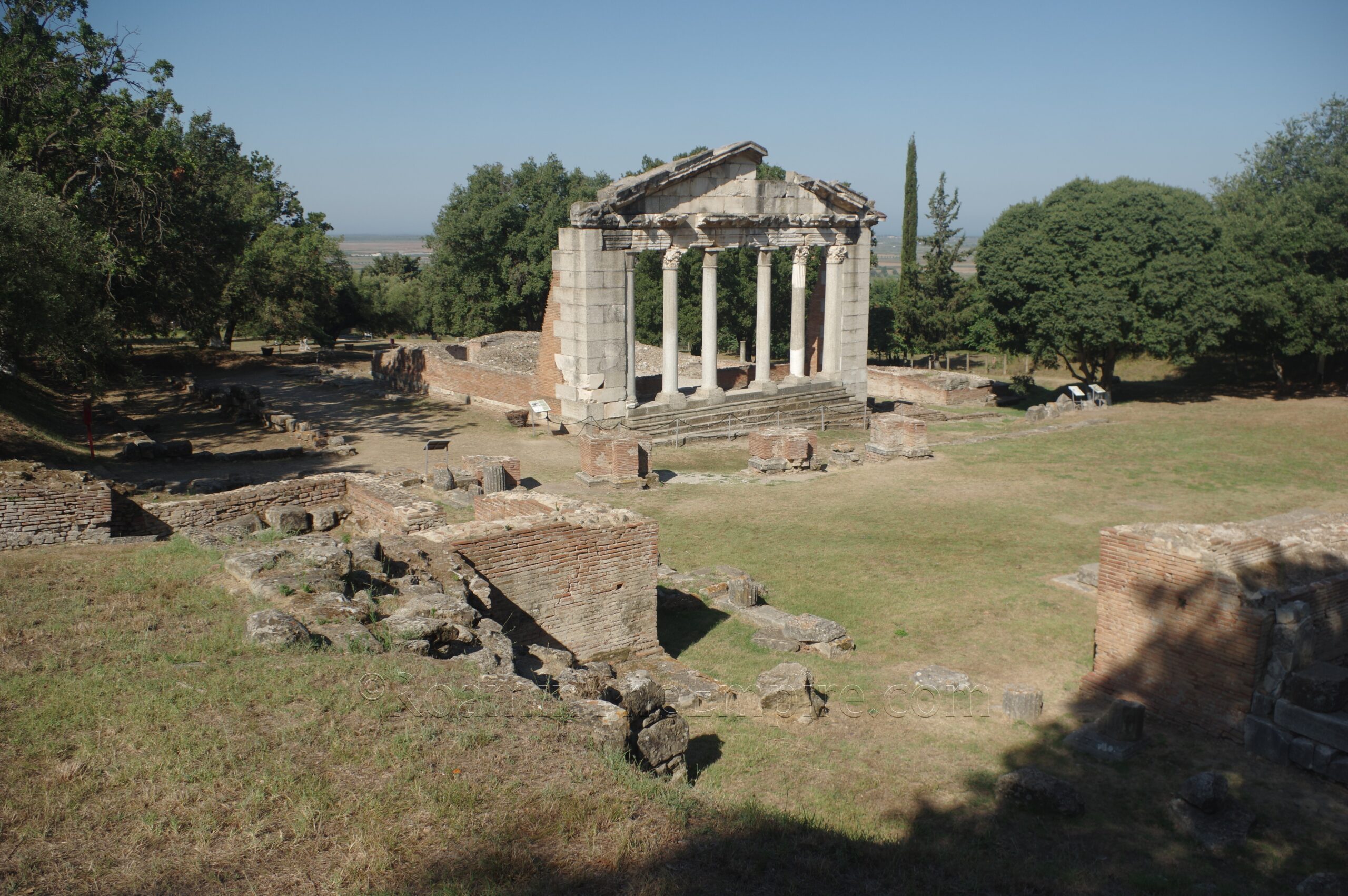
Most Recent Visit: July 2024
Atop a hill overlooking the modern Albanian town of Pojan are the remains of the ancient settlement of Apollonia. Located near the mouth of the Anios (the modern Vjosa, but also called the Aias and Aoos in antiquity), Apollonia seems to have started as a small Greek trading post sometime prior to the late 7th century BCE, possibly. Today the river has since shifted course and the river and mouth are now several kilometers away. Evidence suggests there was Illyrian settlement of the Taulantii people in the vicinity prior to the establishment of the Greek trading post, with the Anios effectively marking the southern boundary of their territory. In addition to a commanding position overlooking the surrounding plains and out to the Mare Adriaticum (Adriatic Sea), it seems to have also been a crossroads for trade routes going back to at least the early Bronze Age.
In the 7th century BCE, the Taulantii enlisted the help of the Corinthians and Corcyreans against the Liburni. After successfully defeating the Liburni, the Greeks were given favorable status among the Taulantii and were allowed to place several colonies in the territory of the Taulantii. One of these was Apollonia. The exact date of foundation and the composition of the colony is a matter of some debate. Generally it is thought to be around 600 BCE, though it is unclear if the colony of 200 settlers was composed of just Corinthians, just Corcyreans, or a mixture of the two. Initially it was called Gylakeia after the leader of this group of colonists, Gylax. By about 588 BCE, the settlement had been renamed Apollonia in honor of the god after the settlers had consulted the oracle of Apollo at Delphi.

Apollonia along with Epidamnus (later called Dyrrachium) to the north were the only Greek colonies on the Adratic coast and were vital to the Greek trade network in that part of the Mediterranean. In addition to the facilitation of trade, Apollonia apparently enjoyed prosperity through agricultural development of the surrounding plain. The settlement was ruled by oligarchs according to Aristotle, a class made up of the original settlers and their descendants, with their subjects seemingly composed mostly of native Illyrians. Apollonia remained a relatively modest settlement through the 6th and 5th centuries BCE, expanding their territory southward to include the oracular sanctuary of Nymphaion and asphaltos (bitumen) mines in the middle of the 5th century BCE. The conquest of Thronion during this time is recorded in a dedication made by the Apollonians at Olympia. Neighboring Epidamnus is mentioned as a focal point at the start of the Peloponnesian War, and Apollonia makes a brief historical appearance as an embarkation point for a Corinthian force sent to reinforce Epidamnus.

The city grew in size and influence during the Hellenistic period. In the late 4th century BCE, Cassander waged a campaign against the Ilyrians to extend Macedonian rule westward. Apollonia was taken by in an initial assault by Cassander in 314 BCE. The following year the city and its Macedonian garrison was besieged by the Taulantii king Glaucias. The Spartan general Acrotatus helped to negotiate an end to the siege, but later that year the Corcyreans assisted the Apollonians in expelling the Macedonian garrison. Cassander returned in 312 BCE to once again attack Apollonia, but he was driven off by a numerically superior force. Apollonia seems to have been included in the territory of Epirus during the reign of Pyrrhus in the first quarter of the 3rd century BCE. Around 260 BCE, the city seems to have entered into an alliance with Rome.

In 229 BCE, Illyrian aggression toward Apollonia, Epidamnus, and Corcyra lead to an intervention by the Aechean and Aetolian Leagues of Greece. Rome was soon drawn into the conflict with an eye toward securing the areas across the Adriatic, ostensibly from Illyrian piracy. In the first in a series of conflicts with Illyria, the Roman consul Lucius Postumius Albinus landed his force at Apollonia (which may have previously been captured by the Illyrians) in 228 BCE to begin his campaign against Illyria. Apollonia pledged their support to Rome and was given Roman protection; following the Roman victory that same year, Apollonia would be declared a free city. In 216 BCE, Apollonia was the target of Philip V of Macedon, who sought an Adriatic port from which to launch an attack on Roman territory, which was in the midst of a series of defeats against Hannibal’s forces in Italy. Upon the arrival of his fleet at Apollonia, Philip V ordered it turned back after the rumor of a large Roman fleet sailing to reinforce Apollonia, which had sought Roman assistance. In reality, the fleet was just a small detachment that would have easily been defeated by the Macedonian fleet.

Philip V again tried to capture Apollonia in 214 BCE, but was unsuccessful and moved to and captured Oricum. The Roman commander Marcus Valerius Laevinus left a garrison at Apollonia and took the remainder of the army down to recapture Oricum, which he was successful in doing. While he was away, however, the Macedonians turned their attention back to Apollonia and laid siege to the city. A contingent of about 2000 Roman troops under the command of the prefect Quintus Naevius Crista was able to sneak back into the city under cover of darkness and join with the garrison. The combined force broke out of the city and defeated the Macedonian army there. Laevinus then blocked the mouth of the Anios, preventing Philip V from retreating by sea and forcing him back to Macedonia overland. Apollonia continued to be a base of operations through the Macedonian Wars and Illyrian Wars into the 2nd century BCE. After the final defeat of the Illyrian Kingdom in 168 BCE, the Apollonians were presented with a portion of the captured Illyrian navy.

Apollonia was incorporated into the Roman province of Macedonia in 148 BCE. Sometime around 130 BCE, it became the terminus of a branch of the Via Egnatia. During the civil war between Gnaeus Pompey and Julius Caesar, Apollonia supported the latter and was used as a base of operations by Caesar in his campaign that included the Battle of Dyrrhachium in 48 BCE. The city was a gathering point for forces committed to Caesar’s planned campaign against Parthia and Octavian was said to be studying in Apollonia at the time of Caesar’s assassination in 44 BCE. Later, after becoming Augustus, he would confer benefits and immunities to Apollonia for their hospitable treatment of him at the time. The following year, in 43 BCE, the city would be captured by one of the assassins, Marcus Junius Brutus, in the civil war stemming from the assassination. Apollonia was described by Cicero as a dignified and noble city, and remained an important port on the Adriatic. It seems to have been re-founded during the time of Nero. In the 3rd century CE, Apollonia entered a period of decline, partially the result of damage from a large earthquake. As the river and coastline changed due to silting Apollonia seems to have largely been abandoned sometime in the 4th century CE.
Getting There: Apollonia is a bit off the beaten path. Fier is the closest city of any consequence. From Tirana, a bus to Fier is around 2 hours and costs 300 lek. The bus leaves from the South and North Terminal fairly regularly during the day; about once an hour, though the schedule seems to change frequently and is dependent on a lot of factors. There is then a bus route that runs from Fier to Pojan, which was a bit complicated. First, the bus stop was not marked at all and I struggled to find it. Second, the schedule is seemingly ephemeral and isn’t really posted anywhere. When I visited, the bus schedule (posted on the bus) was departures to Pojan at 7:30, 8:30, 11:00, 12:30, 14:00, and 15:30. I tried to find the bus the previous day at 15:30 to confirm a schedule I had been given by my accommodation host, but the bus never arrived for that departure. The schedule from Pojan to Fier is 7:00, 8:00, 9:00, 11:30, 13:30, and 14:30. I did end up taking the 7:30 and 14:30 buses respectively, and had no problem with those departures. Tickets were 40 lek each way and the trip was only about 15-20 minutes. From the bus stop in Pojan, it’s just a 10 minute walk (some uphill) to the first major point and 20 minutes to the main site.
Before reaching the main archaeological area of Apollonia, there are a couple points of interest outside of the site, accessible along the way. Less than 5 minutes (300 meters) from the bus stop toward the site, just over the canal and to the left, are the remains of the western gate of the city. Unfortunately I didn’t get a very good look at this particular monument as a bunch of geese from the canal had set up there and were not too keen on me getting close enough to have a gander at the remains of the gate. I make a point of not challenging geese.

Another 5 minutes and about 400 meters west on the road that runs parallel to the canal, and then turns to head uphill to the site, is one of the towers from the city walls. Roughly 30 meters in from the turn, the road runs right through the middle of the tower, and the remains of the circular tower are visible on either side of the road. The foundations of the actual fortification walls are visible just to the east of the tower, as the course of the walls shifted about 16 meters to the east at this tower. The circuit of walls dates to the Hellenistic period, roughly sometime in the 4th or 3rd century BCE.
Continued In Apollonia, Macedonia – Part II
Sources:
Amore, Maria Grazia. The Complex of Tumuli 9, 10 and 11 in the Necropolis of Apollonia (Albania). Vol. 1. Oxford: BAR Publishing, 2016.
Appian. Bella Civilia, 2.8-2.10.
Appian. Bellis Illyricis, 2.8.
Appian. Syriaca, 4.17.
Aristotle. Politika, 1290b.
Bereti Vasil, Quantin François, Cabanes Pierre. Histoire et épigraphie dans la région de Vlora (Albanie). Revue des Études Anciennes, Volume 113 (2011), No. 1, pp. 7-46.
Cassius Dio. Historia, 10.42, 10.141, 12.19, 18, 19.19.1, 41.45-47, 45.3.1, 45.9.3, 47.21-24, 55.29.3.
Değerlendirme, Yeniden. “The Athena Domus at Apollonia (Albania): A Reassessment.” Uludag University Journal of Mosaic Research, Volume 9 (2016), pp. 23-28.
Diodorus Siculus. Bibliotheca Historica, 18.15, 18.58, 19.19, 19.67-70, 19.78, 19.89.
Grant, Michael. A Guide to the Ancient World: A Dictionary of Classical Place Names. New York: Barnes & Noble Books, 1997.
Julius Caesar. Commentarii de Bello Civili, 3.
Livy. Ab Urbe Condita, 24.40, 26.25, 29.12, 31.18-40, 35.24, 37-38, 40.58, 42.18-55, 43.21, 44.30, 45.28-44.
Nicolaus of Damascus. Bios Kaisaris, 16-18.
Omari, Elda and Paolo Bonini. “The Athena Domus at Apollonia (Albania): A Reassessment”. Journal of Mosaic Research, no. 9, 2016, pp. 23-38.
Pausanias. Hellados Periegesis, 5.22.3-4, 6.14.13.
Pliny the Elder. Historia Naturalis, 3.26.2, 24.25.1, 35.51.1.
Plutarch. Brutus, 22, 25-26.
Plutarch. Caesar, 37-38.
Plutarch. Sulla, 27.1.
Polybius. Historiae, 2.9.6, 2.11, 5.109-110.
Sear, Frank. Roman Theaters: An Architectural Study. Oxford: Oxford university Press, 2006.
Smith, William. Dictionary of Greek and Roman Geography. Walton & Murray, 1870.
Stillwell, Richard, William L. MacDonald, and Marian Holland. McAllister. The Princeton Encyclopedia of Classical Sites. Princeton, NJ: Princeton U Press, 1976.
Suetonius. Augustus, 8, 95.
Thucydides. Historia, 1.26.
Vitruvius. De Architectura, 8.3.8, 10.16.9.
Wilkes, John. The Illyrians. Hoboken, NJ: Wiley-Blackwell, 1992.


